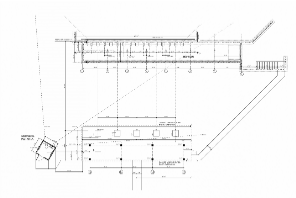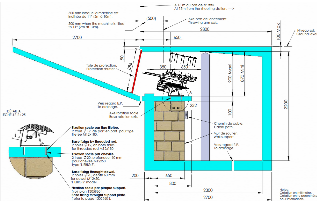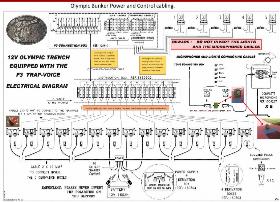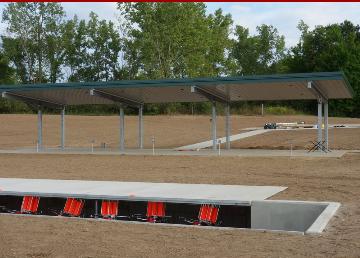Many Universities and Colleges are looking at the possibility of installing an Olympic Bunker discipline at their shooting range. Some of the top shooters, joining the American Team have started their shooting excellence by graduating from a University or College shooting range.
In the past, colleges have installed a Skeet or Trap range and some even expanding into Sporting Clays, but the venture to add Olympic Bunker has always been passed over due to the high expense of such an addition.
In the Olympic Games, shooting is becoming a more "visible sport" and more and more people are following the shooting disciplines. In previous years the following was SKEET shooting, but with expanded TV coverage, Olympic Bunker has become number one choice.
Apart from the choice of equipment, ground selection and preparation, together with bunker construction, run-off and associated support engineering will take a great deal of study and time.
The Shooting Academy helps minimize these tasks and has the expertise to ensure a smooth
project from start to finish.
AMERICAN TRAP VS. OLYMPIC TRAP WHAT IS THE DIFFERENCE by Lester L. Greevy, Jr.
There are two trap games shot in the Olympics. First is Trap in which a single target is thrown. At the Atlanta 1996 Olympics, Double Trap, using 2 simultaneous targets was introduced. Both games differs significantly from their American counterparts. The first difference is the target. The International or Olympic target is larger in diameter (110 mm vs. 108 mm) than the American target. It also has a lower profile and is constructed more substantially and as a result is harder to break. The International target has to be more substantially constructed because it is thrown 76 meters or 83 yards, which is 66% further than the American target's 50 yard flight. The target's flight angles are wider too. The ATA target corresponding to the old #2 hole setting flies within 17.14 degrees each side of the center. The International target extends the angles to 45 degrees each side of center. And not only are the angles wider, but the height varies. The ATA specifies a target shall be between 8 feet (2.4 m) and 12 feet (3.7m) high, 10 yards out from the trap. Nine feet is recommended and the targets are expected to be consistent and regular, the Olympic settings are controlled by 9 tables sometimes called schemes, which set forth explicit elevations and angles for each of the 15 traps. Their elevations taken 10 meters (11 yards) from the front of the trap house or bunker can in any scheme vary from a low of 1.5m (5 ft.) to a high of 3.3m (11 ft.). Imagine a 45 degree right hand target only 5 feet high traveling 83 yards and your next target being a 45 degrees left and climbing to over 50 feet high or anywhere in between and you will start to understand what Olympic trap is all about. International Trap is frequently called Bunker or Olympic Trench. That is because the trap house is over 60 feet long, 8 feet wide, and about 6'6" high inside. It is dug into the ground so that its roof is flush with the ground level, on the same level as the shooting station. It is typically made of concrete, with a concrete roof and looks for all the world, like in military fortification, hence the name Bunker or Trench. Inside the Bunker are 15 traps, set in groups of 3, one group for each of the 5 shooting stations. The traps are stationary and are set each morning to correspond to 1 of the 9 schemes from the rule book. Height, distance, and angle are then verified by a jury, made up of shooters, officials, and organizers. Because the height is set first and then distance and because each trap is set to a different height, but the same distance, all the targets are leaving the trap at different speeds. That adds greatly to the difficulty. The good news is that you are allowed to fire 2 shots at each target and a visible chip from either shot counts as a "hit" target, except in a final round using "flash" target in which "dust" will count as a hit. Flash targets are made with a chalk similar to carpenter's chalk sealed into the concave portion of the target's dome. The chalk leaves a cloud of orange dust in the air when hit solidly and is more easily photographed by the television cameras, which is why they are used in the finals.
In Bunker, there are 5 shooting stations, but they are in a straight line as opposed to an arc, as in ATA. They are each 15 meters back from the front edge of the Bunker and 3 meters apart from each other, centered on the middle trap of the 3 traps set to serve that station. Although there are 5 shooting stations, there are 6 shooters. #6 stands behind station 1. The shooters rotate to the right after every shot instead of after every 5 in a strictly choreographed dance in which #1 shoots, removes his empties, waits for #2 to shoot, then reloads and moves to stand at #2's left side, while #6 moves to station 1. When #3 shoots, #2 moves to his side and #1 assumes station 2 and awaits his turn to shoot. After #5 shoots, he unloads his gun and rotates, walking behind the referee to station 6. This continues until each shooter has fired at 25 targets. A computer controls the selection of targets and each shooter will see the same number of each target which will typically be 2 rights, 2 lefts and 1 straight away from each station. Each station is served by 3 traps set in a group. The center trap, directly in front of the station, and the other traps being each 1 meter to the left and right of the center. The center trap throws its target within 15 degrees of each side of the centerline. The right trap throws up to 45 degrees left and the left trap throws up to 45 degrees right. The guns used in Bunker can be no larger than 12 gauge and are typically over and unders. Semi-autos and pumps are rarely seen. There are 3 primary reasons for this: First, because 2 shots are allowed, 2 different chokes are a definite advantage. A second reason has to do with the superior reliability of the O/U. If only one shot is fired, it is mandatory to clear the action of the semi-auto before you move, but one needs only break open the O/U. Clearing the action of the semi-auto every shot can consume a lot of energy as well as be a distraction to the next shooter who you have just distracted once by bouncing an empty hull off his legs. (Remember, the shooters are standing on the straight line, rather than an arc.) Further, the closing of the semi's bolt tends to set off the voice release microphones required by International Rules. Bunker shooters have developed a unique method of mounting and closing the O/U's just to avoid this problem. There is nothing like ATA squad rhythm in bunker. Each shooter is given 10 seconds from the time the prior shooter completes his shot to call for the target, most take between 6 and 8. They shoot very deliberately with a ritualized setup routine. Matches are shorter. In International competition generally 75 targets are shot the first day and 50 the second. A final of 25 targets is shot by the top 6 scorers and added to their score to determine winner and places. There is a rule proposal in place for the Olympics in which what we now call the final would merely be a semi-final to select the top 4 shooters and in the medal final #3 and #4 would shoot off for bronze then #1 and #2 would shoot off for gold and silver. The reason for this change has to do with television. In Bunker, ammunition is restricted to 24 grams of shot (7/8 oz.). Because of the harder, faster target, 7-1/2's are favored and velocity is generally between 1300 and 1400 feet/second. In American, USAS sanctioned matches, unless you are Master Class or competing for a National Team spot, normal American 1-1/8 oz. loads may be used. In Double Trap, the same guns, targets, shells, field, bunker and shooting sequence are utilized, but targets are thrown only from the middle 3 traps. The center target is a straight away 3.5 meters high measured at 10 meters and the left and right targets are set 5 degrees out from the centerline and 3 meters high. All targets fly 55 meters (60.5 yards) as opposed to the 44-48 yards for US Doubles.
There are 3 different schemes for setting the traps; left and center (A), right and center (B), and left and right (C). A match would be 50 targets from each setting and a final for the top 6 scores on the C setting. In American doubles, 40% of your first shots (stations 2 and 4) are straight aways. Target heights and speeds are the same and your angles are consistent because you are shooting from an arc. Each station being the same distance from the center of the trap. In double trap, only 6 to 13% of your first shots are straight and because the traps are set one meter apart and the shooting stations are on a straight line and there are three schemes, all the angles are different. As a result 50 straights are rare. In Double Trap, you only really need 3 traps and a 12 foot, rather than 60 foot long bunker, so it's less expensive to set up. It is a new game and seems to favor young shooters. Kim Rhode won the Ladies Gold Medal in the '96 Atlanta Olympics at age 17 and Richard Foulds, a 21 year old Brett, won the Mens Gold at Sydney in 2000. I believe that in the United States, Double Trap is the best area for growth in International Clay Target games and the quick ladder to success, particularly for young shooters and especially girls with the desire for Olympic shooting.




